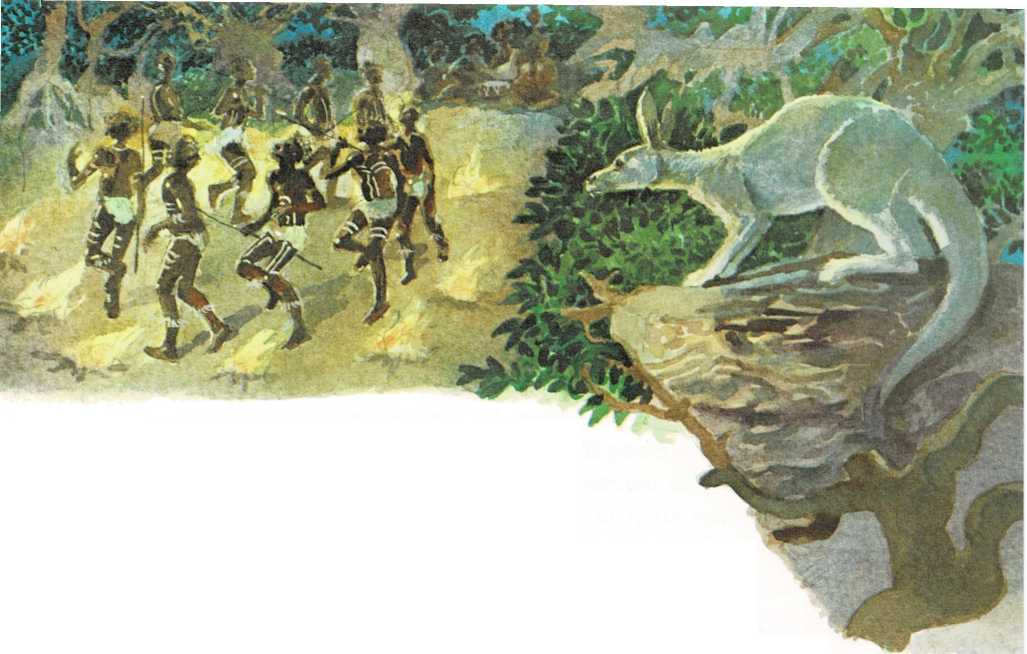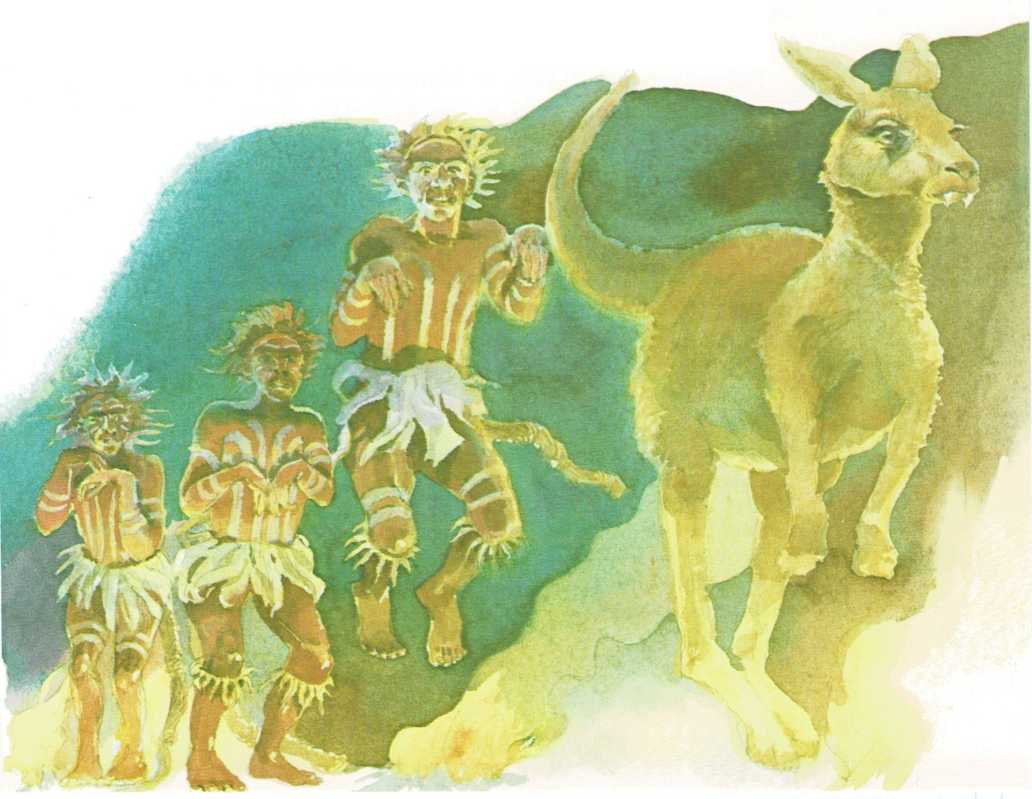
an adaptation of “Bohra the Kangaroo” from Australian Legendary
Tales by K. Langloh ParkerLong, long ago—in the time the Australian Aborigines
call the Dreamtime—Bohra, the kangaroo, did not hop
on two legs as he does today. Instead, he walked on
Why the Kangaroo Hops on Two Legs
four legs, like a dog. And he had four long, pointed teeth, just as dogs
do.
One bright, starry night, as Bohra was nibbling on grass and tender
leaves, he heard the sound of singing. Looking up, he saw the red glow
of many campfires twinkling through the darkness. Filled with curiosity,
Bohra crept closer. When he drew near, he saw that the fires were
arranged in a circle. Within the circle of fires, men were dancing.
Their dark bodies were decorated with red and white designs. Stuck to
some of the painted designs were tufts of fuzzy down from birds such as
Gooloo, the magpie. Women sat outside the circle of fires, singing in
clear voices. As they sang, they clicked clapsticks together and thumped
on rolled-up possum skins. The people were holding a corroboree, or
sacred ceremony.
Round and round went the dancing men. Faster and faster went the
click-click-click of the clapsticks.
Louder and louder went the thump-thumpah-thump on the possum skins.
The fires flickered in the darkness. Overhead, the stars sparkled and
the Milky Way stretched across the sky like a bright, glowing river.
As Bohra watched, he grew more and more interested. The clicking and
thumping excited him. The singing and dancing thrilled him. He felt that
he, too, wanted to dance—-just as the men were dancing. Suddenly,
standing up on his hind legs so that he would look like the men, he
jumped into the circle of fires! Balancing himself with his tail, he
began to hop behind the dancers.
At the sight of him, the women stopped singing and began to shriek and
point. The men stopped dancing and looked to see what the trouble was.
When they saw Bohra standing on his hind legs trying to imitate them,
some were angry. “Kill him!” they shouted. But others said, “No, no. Let
us see him dance.”
The women were told to start their singing again, to beat the possum
skins and click their clapsticks. As they did so, the men began to
dance. And after them, at the end of the line, came Bohra. He was
hopping on two legs and trying to do what the men did.
As the men danced, they turned their heads to watch Bohra. Soon they
began to grin and chuckle. Bohra looked very funny hopping around so
seriously, a timid expression on his face, and his tail leaving a
snakelike track behind him. Finally, the men were laughing so hard they
had to stop dancing.
Then, one of the men had an idea. He led the others out of the circle
and into the surrounding darkness. There he had them gather bundles of
long grass. He told them what he wanted them to do, and the men quickly
went to work.
After a time, the men called to the women to pile more wood on the fires
and start their singing. As the fires rose higher and higher, the women
clicked their
clapsticks, thumped on the possum skins, and raised their voices in
song. Then the line of painted men came back into the circle of fires.
But now, hanging from the backs of their belts were long, crude tails of
woven grass.
The men began to dance the way Bohra danced.
They hopped round the ring as Bohra did, their grass tails waggling
behind them. They held their arms up in front of them, with their hands
dangling down, the way Bohra held his forepaws as he danced. The men
looked so funny the women could hardly manage to sing.
At last, with a great “Hooh! Hooh! Hooh!” from the dancers, the singing
and clicking and thumping faded into silence. The tired dancers sank to
the ground. It was nearly dawn. Already the laughing cries of the
kookaburra birds could be heard.
After a few moments, an old wirinun, or magician, stood up. “This Bohra
came to our corroboree without

being invited. He must be shown that he has no right to do this,” said
the wirinun. “But, we will not kill him, for he has shown us a new
dance. Instead, from now on, he and all his tribe shall hop on their
hind legs, using their tails to balance themselves—just as he hopped
when he was dancing. And they shall hold their forepaws up in front of
them, just as he did.” Motioning to the others to follow him, he said,
“Now, let us make this Bohra one of us. He and his tribe shall be our
brothers. Then, if any of them see our corroborees, they will not tell
others what they have seen.”
The men took Bohra into the trees, away from the fires and the women.
There they performed the ceremony that made him a member of their tribe.
It was the same ceremony that their young boys went through when they
came of age. As part of the ceremony, the wirinun took a boomerang and
knocked out Bohra’s long, pointed teeth.
From that day to this, no kangaroo has had these long, pointed teeth.
And to this very day, every kangaroo hops on two legs, the way Bohra did
that night when he joined the corroboree. And ever since that time, when
the people of the Bohra tribe have a corroboree, they put on tails made
of woven grass. Then they dance the kangaroo dance—just as Bohra
danced it on that starry night in the long-ago Dreamtime.
[sye]{.smallcaps}
There are many, many wonderful “why” stories. If you haven’t read them,
try “How the Camel Got His Hump” and Why Mosquitoes Buzz in People’s
Ears, both in Volume 1 of Childcraft. Or get the book, Tales of the
Nimipoo by Eleanor Heady, which has twenty “why” stories with Coyote,
the American Indian trickster, as the hero.

